“The Way It Looks Today: A Camera Tour of Church History Sites in New England, New York, Pennsylvania, and Ohio,” Ensign, Sept. 1978, 33
The Way It Looks Today:
A Camera Tour of Church History Sites in New England, New York, Pennsylvania, and Ohio
Many Saints will celebrate the approaching one hundred and fiftieth anniversary of the Church’s organization by touring important Church history sites. But many others will not be able to give themselves that birthday present.
Thus, beginning with this issue and continuing in other issues for the next two years, the Ensign has planned photo essays of “the way it looks now”—in New York, Kirtland, Missouri, Nauvoo, and so on. From the homes that sheltered Joseph Smith’s parents as children, this photo essay will take Church members over the ground traveled by the Saints up through the organization of the Church.
This journey would not have been possible without the assistance of Larry C. Porter, chairman of BYU’s Church History and Doctrine department; LaMar E. Garrard, who accompanied the photographer to New England; Russell R. Rich, who performed the same service in New York; and A. Gary Anderson, who provided caption information. Two other sources—recommended for interested students—were Richard L. Anderson’s Joseph Smith’s New England Heritage (Salt Lake City: Deseret Book Company, 1971), and Lucy Mack Smith’s biography of the Prophet’s life. Photographers for this essay were Jed A. Clark and Longin Lonczyna, Jr.

Joseph Smith’s great-great grandfather built the Smith home in Topsfield, Mass., about fifty feet behind this dignified residence. Joseph’s father, Joseph, Sr., was born in this same house four generations later, into a family with an honored reputation for community service.

This cast granite statue of a World War I doughboy honors “the men of Marlow, [New Hampshire], who … did not hesitate” to defend their country through the Revolutionary War, the War of 1812, the Civil War, and World War I. The smaller stone honors those who served in World War II. Solomon Mack migrated to Marlow from Connecticut in 1761 to become its first resident. Six of his eight children were born here.

A monument honoring Revolutionary War soldiers from Marlow, New Hampshire, includes three relatives of the Prophet. Silas and Zopher were his mother’s first cousins. All three fought at Ticonderoga in 1777.

Solomon Mack and two brothers, Elisha and Samuel, first bridged the Connecticut River about 1790. A string of bridges, dams, and mills testify to their ability and industry.
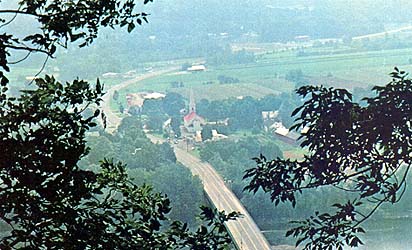
Just beyond the Connecticut, Sunderland, Mass., lies misty. Here Lucy Mack’s oldest sister, Lovisa, wasted away for two years, then revived dramatically on her deathbed and spent three healthy years testifying that the Lord had healed her to witness to her neighbors of the coming judgment.
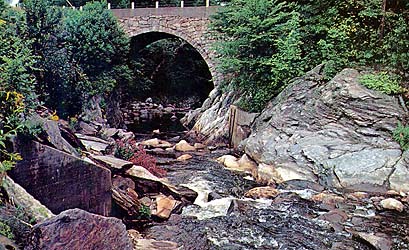
Lucy Mack’s father and uncles were the first to span the Asheulot River near Marlow, Conn. Their wooden bridge, the only one for miles between about 1778 and 1795, was later replaced by this stone bridge. A few dressed stones, left bank, mark the Mack mill site.
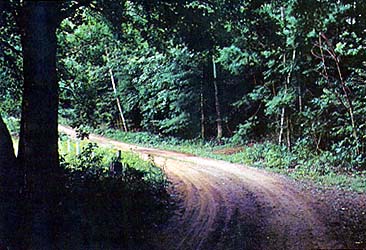
In the trees right of the bend lies the Mack home site in Gilsum, New Hampshire, where Lucy was born and her father returned to die in 1820. Crippled by a series of accidents, he spent his last nine years riding about sidesaddle, preaching “in my Father’s service” having discovered religion in 1810–11.

Tunbridge Gore, Vt., was the first home of Joseph and Lucy Smith after their 1796 wedding, the birthplace of Alvin, Hyrum, and Sophronia, and the family farm for six years. Stones and a cellar hole near the bushes and curving road in the center of the photograph mark the traditional homesite of the newlyweds. (A “gore” is a strip of unsurveyed land; this one was later annexed.)
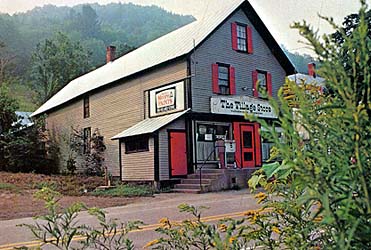
Tunbridge’s general store, still in use after 160 years, is traditionally where Joseph and Lucy first met. Her brother Stephen and his partner owned a store—this one?—and four other flourishing businesses in town.
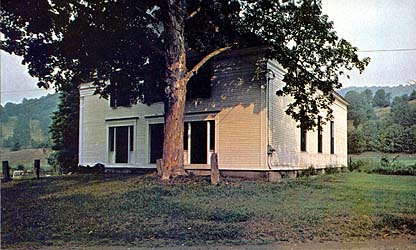
Joseph Smith, Sr., was probably a member of this simple Universalist Church in North Tunbridge, Vt., and may have preached some sermons in it. His father, Asael, moderated its founding meeting; Joseph and sixteen others signed a document requesting exemption from the normal town tax used to finance the Congregationalists.
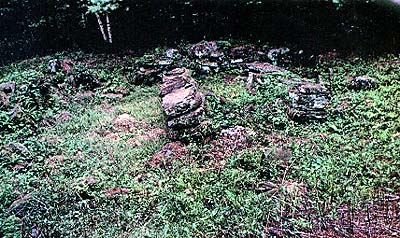
The traditional site of Solomon Mack’s home in Sharon, Vt., just a quarter mile northeast of the Joseph Smith monument, is marked by these foundation stones. He reportedly kept this turnpike home from 1804 to about 1810.
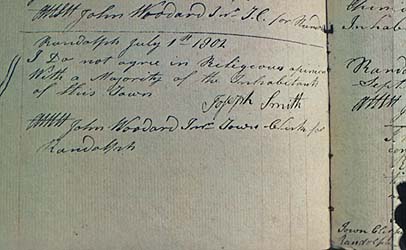
One sentence in the Randolph, Vt., records signed by Joseph Smith, Sr., again requests Congregationalist tax exemption: “I do not agree in Religious opinions With a Majority of the Inhabitants of this Town.” Here the Smith mercantile business failed because of a dishonest associate.
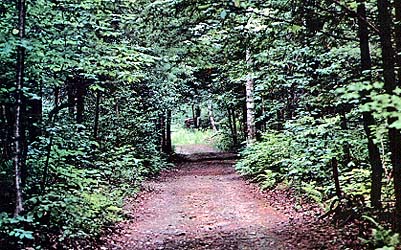
From Randolph, the family moved to Tunbridge, to Royalton, and then to Sharon where Joseph rented part of his father-in-law’s farm by this turnpike. The Prophet Joseph was born on 23 December 1805 in a house on the township line. (The bedroom was in the Sharon end.)

A gentle slope leads from the doorstep of the log cabin in which Joseph Smith was born to the Prophet’s monument at Sharon, Vt., a 38 1/2-foot shaft of native granite, one foot for each year of his life. The round plaque and white granite monument describe a 1905 memorial cottage placed on the cabin’s foundation. The granite shaft weighs thirty-nine tons and had to be drawn six miles upgrade by a twenty-two-horse team over muddy ground that providentially froze.

A view of the Joseph Smith memorial at Sharon shows a reflecting pond, the visitors’ center on the left with missionary quarters, and, on the right, a visitors’ center containing the Smith home’s hearthstone.
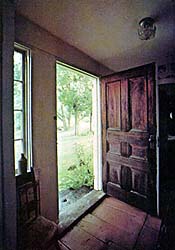
The Norwich, Vt., home that the Smiths probably came to about 1813. Still a family residence, it has been beautifully maintained by the Howard Cook family.

The original staircase and door show the careful craftsmanship that could be created with simple hand tools.
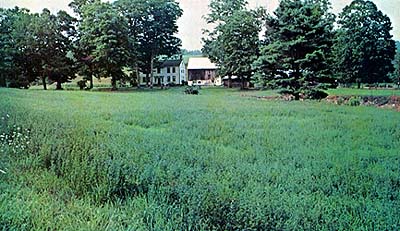
Norwich was the Smiths’ last residence before they moved to Palmyra in 1816, perhaps drawn there by glowing advertisements in their local paper for fertile land in western New York.
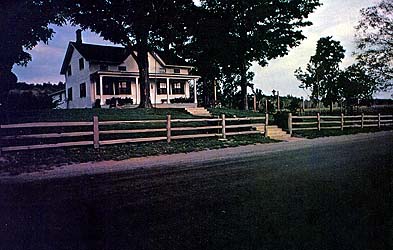
Alvin Smith began this frame house in Manchester for his parents in 1822, before his death.
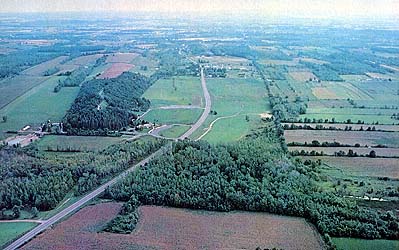
Aerial view of Hill Cumorah looking south; visitors’ center on west; Rochester New York Stake farm on east.
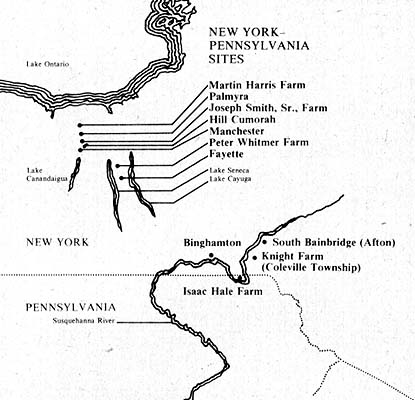
New York–Pennsylvania Sites
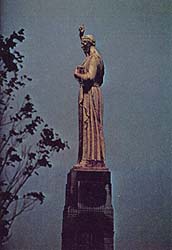
Statue of Moroni, 10 feet 4 inches high, atop the Hill Cumorah, was dedicated in 1935.
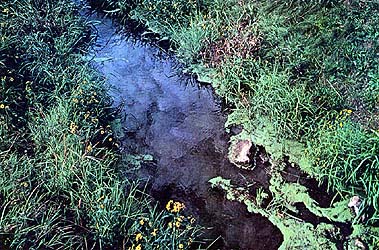
Hathaway Brook runs through the Smith farm in Manchester Township.

Tailored fields surround the Martin Harris farm in the foreground. A little north is the village of Palmyra. The Lakeshore cobblestone home, now a visitors’ center, replaced the original frame house, which burned. Martin Harris was living here when he lost the first 116 manuscript pages of the Book of Mormon; later, to pay the $3,000 required by Egbert B. Grandin for printing 5,000 copies, he redeemed his mortgage by selling 151 acres to Thomas Lakey.

A simple headstone marks the grave site of Joseph’s older brother, Alvin, who died 19 November 1823 from a “dose of calomel” which “lodged” in his stomach. His last words to Joseph counseled him to “be a good boy, and do everything that lies in your power to obtain the Record. Be faithful in receiving instruction, and in keeping every commandment.”

The aerial view of Palmyra’s Main Street shows the Ben Franklin store, marked by a double row of white framed windows and a flat roof, right of the red brick building. Formerly it was Egbert B. Grandin’s establishment where the Book of Mormon was printed on the third floor, bound on the second, and sold in the ground-floor bookstore. His press is now in the Church’s possession.
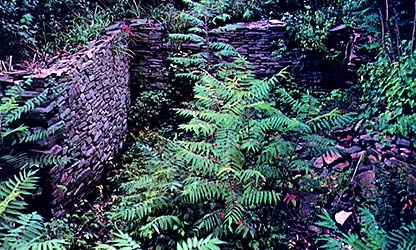
These carefully laid rock foundations are all that remain of the Isaac Hale home in what was Harmony Township, Susquehanna County, Pennsylvania. Joseph Smith met his future wife, Emma, here in 1825. They lived here briefly from December 1827, then moved to a nearby homestead.

The grassy mound above marks Joseph and Emma’s Harmony Township home where most of the Book of Mormon was translated and fifteen sections of the Doctrine and Covenants received. Near this spot the Aaronic Priesthood was restored. In the cemetery are the graves of Emma’s parents, niece, and first child.

In the aerial view, the homesite lies left of the road, at the far end of the parking lot, which leads to the Aaronic Priesthood monument. Emma’s childhood home is across the road near the bend, toward the center of the photograph.

[Above] is South Bainbridge, now Afton, New York, where Joseph and Emma were married in 1827 in Zachariah Tarble’s home, now replaced by the county fairground’s double racetrack.
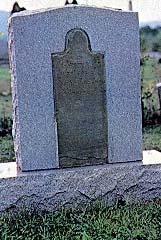
The slate headstone of Joseph and Emma’s infant son has been affixed to a granite monument. Of their nine children, five died in infancy.

A few rods from this granite and bronze monument, a gift from 60,000 boys and their leaders, the Aaronic Priesthood was restored in 1829.
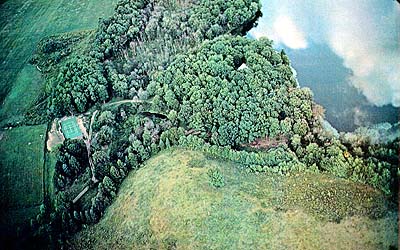
A fraction of Pickerel Pond on the Joseph Knight farm, Colesville Township, New York, reflects the sky. The Knight family, among the Prophet’s earliest and most faithful supporters, operated a carding mill on the pond’s outlet.
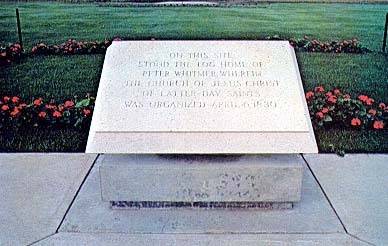
A square of flowers, four red metal posts, and a simple plaque identify Peter Whitmer, Sr.’s homesite in Fayette, Seneca County, New York, where the Church was organized 6 April 1830. About fifty members gathered at the one-and-a half story home, as many as possible crowding into the 20′-x-20′ room.
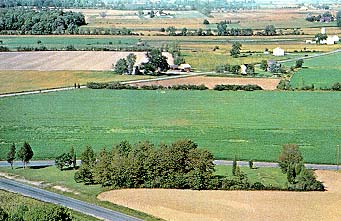
The site of Fayette’s old Jerusalem Church, a German Reformed congregation, is marked by the grove of trees in the foreground. It burned, leaving only its cemetery, but a contemporary of Joseph Smith’s calls it “the first church edifice in which Mormon services were held.” The Whitmers were members of this church, and their farmhouse, ringed by a circular driveway, lies in about the middle of the photograph. The churchyard lies at the intersection of State Highway 121 and Watts Road in Seneca County, New York.
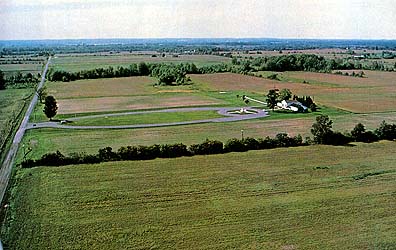
The Peter Whitmer house, six miles northwest of Fayette, gleams in its setting of trees and green fields. The L-shaped Greek Revival house, expanded with a wing, serves as a visitors’ center. It was constructed between 1845–51 about 100 yards west of the original home where the Church was organized.